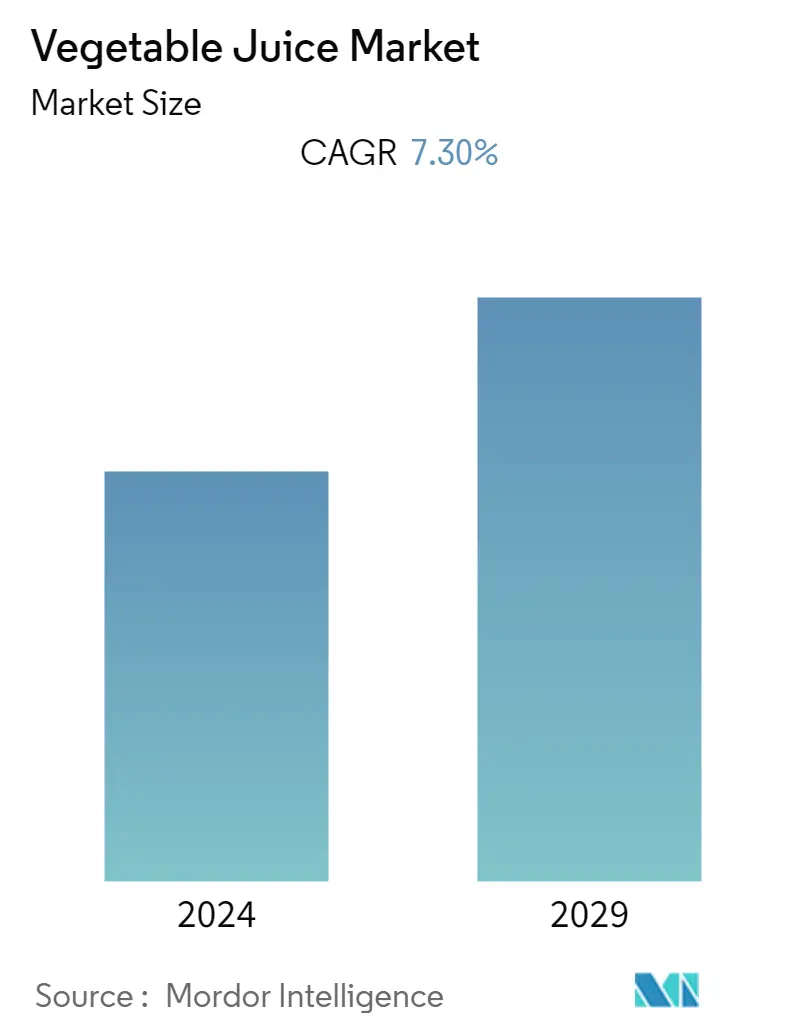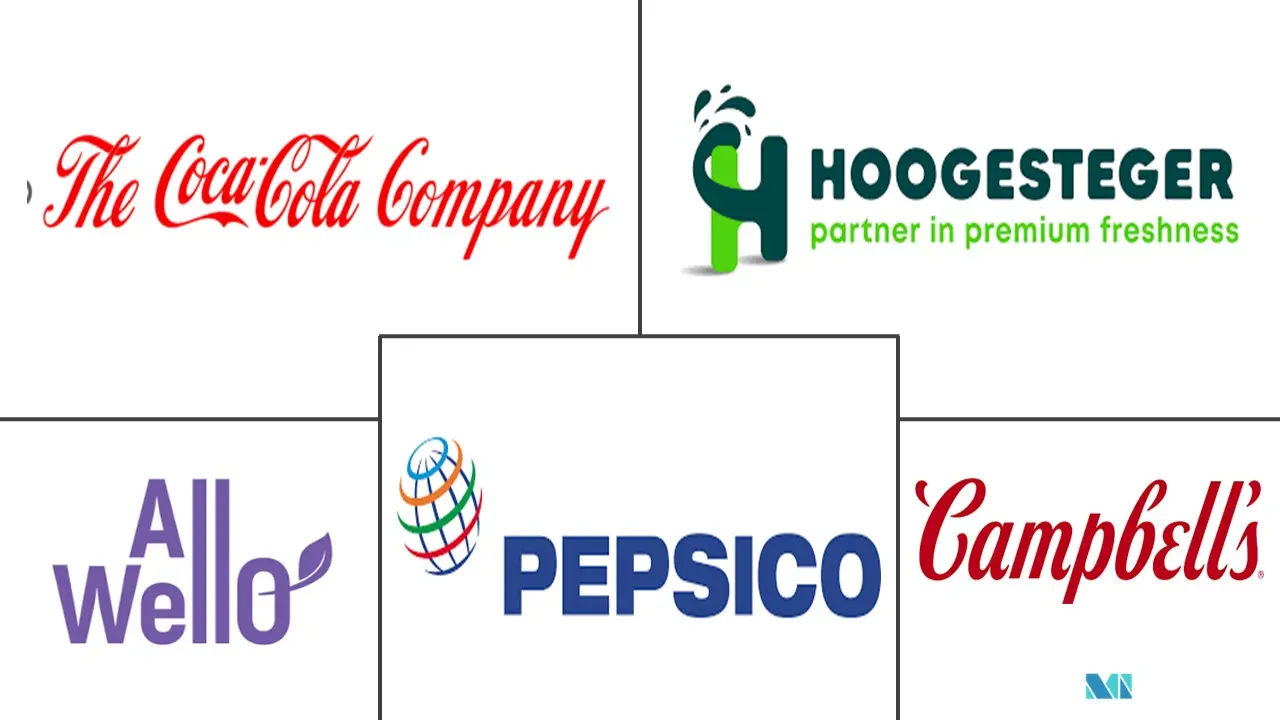Market Size of Vegetable Juice Industry

| Study Period | 2019 - 2029 |
| Base Year For Estimation | 2023 |
| CAGR | 7.30 % |
| Fastest Growing Market | Asia-Pacific |
| Largest Market | North America |
| Market Concentration | Low |
Major Players
*Disclaimer: Major Players sorted in no particular order |
Vegetable Juice Market Analysis
The Global Vegetable Market is projected to register a CAGR of 7.3 % during the forecast period, 2022-2027.
Vegetable juices are crucial parts of a healthy diet and, when consumed in moderation and balance, may help prevent serious illnesses including cancer and cardiovascular disease. There is increasing consumption of vegetable juice worldwide as young generation consumers are increasingly inclined towards healthy food and beverages owing to their nutritional values vegetable juices are high in phytonutrients, phenols, and antioxidants that improve blood circulation, help eliminate free radicals from the body and strengthen the immune system. Owing to such factors manufacturers are focusing on innovating a range of vegetable juice blends with fruit, herbs, and spices to capture the growing demand and achieve a competitive advantage in the market. For instance, in 2021, Dabur revamped the products in its juices portfolio under its brand Real Activ, which has a variety of juices created with a combination of fruits and vegetables, such as cucumber + spinach, and beetroot + carrot. In particular, the products are reintroduced with new packaging claims that the juices have multiple benefits, such as immunity boosting, being good for gut health and helping promote heart health.
In short term, the development and introduction of novel products into the market are likely to be influenced by the growing number of health-conscious consumers and rising public awareness regarding the advantages of clean-label products and organic vegetables for health. Further, the outbreak of covid-19 has affected people's behavior to a great extent as people have shifted towards natural and organic food and beverage products with the presence of healthy ingredients, and for that, they are willing to spend more.
Additionally, the introduction of vegetable blend juices has enticed fresh entrants and has had a significant positive impact on the industry due to the additional nutritional quantities associated with it. Since these products add nutritional value, they are preferred by a large percentage of people. Hence, the above-mentioned factors have provided consumers with a wide range of options to choose from, thereby driving market growth.
Vegetable Juice Industry Segmentation
Vegetable juice can be described as a drink that is prepared with a blend of different types of vegetables, together into a drink that is served in snacks, breakfast, and ingredients for cocktails to enhance flavor. The vegetable juice is frequently combined with fruits such as apples, carrots, and herbs mixed juice. The global vegetable juice market (henceforth referred to as the market studied) is segmented by product type, category, packaging, distribution channel, and geography. By product type, the market is segmented into carrot, spinach, kale, and other product types. By category, the market is segmented into cold-pressed and conventional. By packaging, the market is segmented into bottles, cans, and others. Based on the distribution channel, the market studied is segmented into supermarkets/hypermarkets, convenience stores, online retail stores, and other distribution channels. It provides an analysis of emerging and established economies across the world, comprising North America, Europe, South America, Asia-Pacific, the Middle East, and Africa. For each segment, the market sizing and forecasts have been done based on value (in USD million).
| By Product Type | |
| Carrot | |
| Spinach | |
| Kale | |
| Other Products |
| By Category | |
| Cold-Pressed | |
| Conventional |
| By Packaging | |
| Bottle | |
| Cans | |
| Others |
| By Distribution | |
| Supermarkets/Hypermarkets | |
| Convenience Stores | |
| Online Retail Stores | |
| Other Distribution Channels |
| Geography | |||||||||
| |||||||||
| |||||||||
| |||||||||
| |||||||||
|
Vegetable Juice Market Size Summary
The vegetable juice market is experiencing significant growth, driven by increasing consumer awareness of health benefits and a shift towards natural and organic food products. As younger generations prioritize nutritional value, vegetable juices, rich in phytonutrients, phenols, and antioxidants, are becoming a staple in healthy diets. This trend is further supported by the rising popularity of cold-pressed juices, which retain essential vitamins and minerals. The market is witnessing innovation in product offerings, with manufacturers blending vegetable juices with fruits, herbs, and spices to cater to diverse consumer preferences. The COVID-19 pandemic has accelerated this shift, as more people seek immune-boosting and health-promoting beverages, willing to invest in products that align with their wellness goals.
North America leads the vegetable juice market, fueled by a strong health consciousness and a preference for active lifestyles. The region's consumers are increasingly opting for vegan and nutrient-dense juice options, such as leafy greens and root vegetables, which are rich in protein, minerals, and vitamins. Major players in the market, including Naked Juice Company, Dr. Pepper Snapple Group, and The Coca-Cola Company, are expanding their product lines and enhancing their market presence through strategic alliances and innovative product launches. The competitive landscape is characterized by a mix of regional and international manufacturers offering organic and chemical-free options, catering to the growing demand for healthier lifestyle choices.
Vegetable Juice Market Size - Table of Contents
-
1. MARKET DYNAMICS
-
1.1 Market Drivers
-
1.2 Market Restraints
-
1.3 Porter's Five Force Analysis
-
1.3.1 Threat of New Entrants
-
1.3.2 Bargaining Power of Buyers/Consumers
-
1.3.3 Bargaining Power of Suppliers
-
1.3.4 Threat of Substitute Products
-
1.3.5 Intensity of Competitive Rivalry
-
-
-
2. MARKET SEGMENTATION
-
2.1 By Product Type
-
2.1.1 Carrot
-
2.1.2 Spinach
-
2.1.3 Kale
-
2.1.4 Other Products
-
-
2.2 By Category
-
2.2.1 Cold-Pressed
-
2.2.2 Conventional
-
-
2.3 By Packaging
-
2.3.1 Bottle
-
2.3.2 Cans
-
2.3.3 Others
-
-
2.4 By Distribution
-
2.4.1 Supermarkets/Hypermarkets
-
2.4.2 Convenience Stores
-
2.4.3 Online Retail Stores
-
2.4.4 Other Distribution Channels
-
-
2.5 Geography
-
2.5.1 North America
-
2.5.1.1 United States
-
2.5.1.2 Canada
-
2.5.1.3 Mexico
-
2.5.1.4 Rest of North America
-
-
2.5.2 Europe
-
2.5.2.1 United Kingdom
-
2.5.2.2 Germany
-
2.5.2.3 Italy
-
2.5.2.4 France
-
2.5.2.5 Spain
-
2.5.2.6 Russia
-
2.5.2.7 Rest of Europe
-
-
2.5.3 Asia-Pacific
-
2.5.3.1 India
-
2.5.3.2 China
-
2.5.3.3 Japan
-
2.5.3.4 Australia
-
2.5.3.5 Rest of Asia-Pacific
-
-
2.5.4 South America
-
2.5.4.1 Brazil
-
2.5.4.2 Argentina
-
2.5.4.3 Rest of South America
-
-
2.5.5 Middle East & Africa
-
2.5.5.1 South Africa
-
2.5.5.2 Saudi Arabia
-
2.5.5.3 Rest of Middle East & Africa
-
-
-
Vegetable Juice Market Size FAQs
What is the current Vegetable Juice Market size?
The Vegetable Juice Market is projected to register a CAGR of 7.30% during the forecast period (2024-2029)
Who are the key players in Vegetable Juice Market?
The Coca-Cola Company, Naked Juice Company (PepsiCo., Inc.), Hoogesteger, AllWellO and Campbell Soup Company are the major companies operating in the Vegetable Juice Market.

